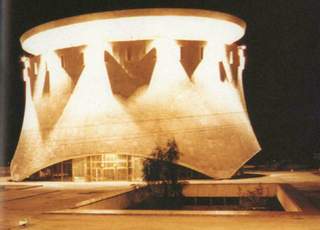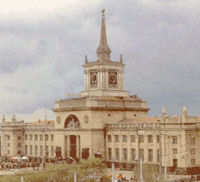| VOLGOGRAD PROJECT | ||||||||||||||||||||||||||||||||||||
GROUP HA-991, 2003 |
||||||||||||||||||||||||||||||||||||
| About Volgograd in short: | ||||||||||||||||||||||||||||||||||||
Poviraeva Irina |
||||||||||||||||||||||||||||||||||||
| · | Volgograd is one of the largest centers of
international tourism. Thousands of tourists arrive to Volgograd every day by planes, by
trains, by ships and by buses. Besides historical places known to the whole world, the
visitors of our town go to Volga-Akhtuba flood-meadows, make boat rides
on the Volga-Don navigation canal, get familiar with the history and
everyday life of the town. · In the town there are hundreds of modern stores, canteens and cafes, markets and restaurants, ateliers and repair shops. There is a number of comfortable hotels, stadiums and parks. · The cultural-rehabilitation complex includes medical institutions, 256 children's pre-schools institutions, 194 secondary schools, 10 independent state institutions of higher education, 68 libraries, 13 cinemas, 5 museums, 8 theatres, an art gallery and a circus. · In Volgograd there are 10 broadcasting stations, 14 TV channels, over 200 newspapers, week lines and magazines are issued. · The town is a strategic traffic center, through which pass important railway systems, federal thoroughfares, a transnational air corridor, water systems for river and sea shipping using the Volga-Don navigation canal. There are Higher Educational Institutions famous throughout the region: - Volgograd State University www.volsu.ru - Volgograd State Pedagogical University www.vspu.ru - Volgograd Agriculture Academy - Architectural Academy - Volgograd State Politechnical University - Volgograd Medical Academy was opened in 1935. At present there are 8 faculties at the Academy: general medicine, stomatological, pediatric, pharmaceutical, preparatory course for foreign students, post diploma training, refresher courses. For the whole period of the Academy existence 23000 physicians graduated from this educational establishment. 2000 graduates were from foreign countries. WHO and 80 countries in the whole world acknowledge its diplomas. |
|||||||||||||||||||||||||||||||||||
| Information for the tourist | content | Shefer Olga |
||||||||||||||||||||||||||||||||||
How to get to Volgograd Sometimes there is a direct connection between Volgograd and any foreign country. But if there is not any (for example between Volgograd and USA cities) so you should fly to Volgograd via Moscow. The flight from Moscow to Volgograd takes 1 hour 40 minutes. The cost is about 70 US dollars. Airport Volgograd airport is 18 km from the city centre. Different buses to the airport run every half hour from the Alley of Heroes. Railway Volgograd is a major railway junction and is connected by rail to Moscow, Sankt-Petersburg, ports on the Black Sea, the Sea of Azov and the Caspian Sea and other cities. The journey from Volgograd to Moscow by rail takes 18 hours. Volgograd railway station is 300 metres from Fallen Heroes Square. Volgograds third gate is its port on the river. There are passenger boats, heavy tankers, barges and floats. Passenger boats moor at the quays less than 500 metres from the centre of the city, but the docks handling freight are to the south beyond the dried up river Tsaritsa. From Mai to October Volgograd is one of the places on the route of the Volga cruise. Hotels As a rule tourists coming from abroad stay either at the Intourist ( 14, Ulitsa Mira) or at the Volgograd (12, Ulitsa Mira), which are in the centre of the city. Both hotels are within easy reach of the main sights of the city as well as the museums and shops, and the Volga is only 10 minutes walk away. The hotels have service bureaux where tourists can register and complete the necessary passport formalities and book journeys through the Russia offered by Intourist. The service bureaux handle tickets for theatre as well as for excursions around and outside the town. Hotel restaurants are open from 8 a.m. to 12 p.m. There is a first-aid room in each hotel. City transport About all districts of the city are connected by trams, trolleybuses and small coaches (or "shuttles") costing from 4 to 10 rubles for a single journey. Tickets are to buy on the board. Trams, trolleybuses and buses run from 6 a.m. to 12 p.m. City transport includes the river motorboats, which go to the island and the left bank of the Volga, where the holiday grounds and beaches are located. There is no timetable for these boats - they leave one after the other from 5 a.m. to 11 p.m. There are shops of all kinds from small
vegetable stalls to huge gigasupermarkets. They have
diverse working hours, most of them open from 8-9 a.m. to 9-10 p.m.
Supermarkets are open till 11 p.m. and some of them work day and night.
There are some good chain shops: "Radezh" chain includes the
best Entertainment Centre with a modern cinema, bowling centre and an
open-air skating rink. The most popular chain now is "Man" which
has supermarkets in every district. Very convenient is the system of
24-hour shops "Vishenka" with a cherry sign on it. |
|
|||||||||||||||||||||||||||||||||||
| Places of Interest and Town Attractions | content | Shefer Olga |
||||||||||||||||||||||||||||||||||
|
The River Volga The broad, deep waters of the Volga almost invite you to take a boating trip. The river trams, as they call them When is Volga at its most beautiful? In spring, when its waters rise in boundless flood and the first fluffy trace of green appears along its banks, when the rain lashes its water in brief cloudbursts and its gullies are the colour of blossoming cherry?.... Or in summer, when the sun is mirrored and miltiplied in every drop of its water and a warm breeze wafts from its banks the scent of limes and aromatic herbs?... Or perhaps autumn? Then its waters are cold and leaden in the early morning light and the nights are black and pitch. But in the daylight its wooden banks blaze with colour - reds and golds and russets.... Or maybe in winter, when the glistening ice grips the Volga and the nacked forests stand in stark splendour and peace and tranquility descend upon the mighty river?.... Every nation has its main river, determined not so much by its lenght or its depth as the part it has played in the fate of the nation. The main river in Russia is the Volga. In ancient times it was called Ra (the generous). In the middle ages it bacame known as Itil which means river of rivers. Scholars think that the word Volga is of Finnish origin and means bright or holy. The Volga is 3,530 km in lenght - is the largest river in Europe. At Volgograd it is 2 km wide and between 4 and 25 metres deep. The Volga has always been an important transport route, but its high tides and low ebbs makes shipping difficult. |
||||||||||||||||||||||||||||||||||||
| Railway station In the western part of Privokzalnaya ploshchad (Station Square) is the main railway station, built in 1954 on the site of the old station which was destroyed in 1942. On the station tower, which is 67 metres in height, is an enormous clock. The clock face is 4 metres in diameter and each hand is 2.5 metres long. Press House In 1960 the Press house was built on Station Square by the engineer G. Sysoev according to a design by the architect G. Borisenko. This is the head of the local newspapers: Volgogradskaja Pravda, Izvestia Komsomolskaja Pravda and others. From Station Square we come along the shortest street in Volgograd, Gogol Street, into the central square of the city - Fallen Fighters Square. |
content
|
|||||||||||||||||||||||||||||||||||
Leaving Fallen Fighters Square by the Alley of Heroes - one of the most beautiful tree-lined streets in Volgograd - we come to Central Embankment, which is named after the 62nd Army. From the high right bank there is a magnificent view over the Volga, giving a fine impression of its peaceful , majestic flow. On a hot summer day a cool bracing wind blows from the Volga. Volgograders love to stroll along the embankment. Children play here, and after the last day at school young people gather to see-in the dawn. On public holidays and other festive occasions people come here to watsh the firework displays. This part of the city is very attractive. The wide granite steps, the snow-white pillars, the granite lanterns and the emerald green of the park harmoniously blend in with the architecture along the embankment in the centre of the city. |
||||||||||||||||||||||||||||||||||||
|
Lenin Avenue is the main street in Volgograd. It
runs parallel to the Volga for 14 km, and connects the Central District
with the two northern districts - Red October and Tractor Plant. The avenue begins at the
river Tsaritsa and ends at Dzerzhinsky Square in the Tractor Plant
District. There are many shops, which specialise in various goods: books, jewelry,
souvenirs, cloths....Down the centre of the avenue runs a tree-lined alley decorated with
shrubs and flower-beds. As you walk along Lenin Avenue you will cross several small
streets. One of these is called Komsomol Street (Komsomolskaja Ulitsa). At the crossing of Komsomol Street and Lenin Avenue a monument to the Komsomols, by the sculptor M. Krivolapov, was erected in honour of the 30th Anniversary of the victory at Stalingrad. On a low pedestal, almost at ground level stand a group of young soldiers. Grief is written on their faces, grief at a dead comrade. Running parallel to Komsomol Street is a small tree-lined street, called Port-Said Street.On the corner of Lenin Avenue and Port-Said Street is the Museum of fine Arts. he picture gallery which existed in pre-war Stalingrad, was destroyed by fascist bombs in 1942. |
|||||||||||||||||||||||||||||||||||
| Thanks to the considerable help from
other museums throughout the country, the Volgograd museum now has around 3,000 exhibits
of ancient, West-European, Russian and Oriental art. Number 14, Gagarin Street, to the left of Lenin Avenue, is the Volgograd Planetarium. It is decorated in marble, granite and valuable rosewood. In the central hall is the planetarium a piece of optical appartus built at the Zeiss-Werke plant in Jena. Other appartus demonstartes the rising of the sun, the scintillation of the stars, the Aurora Borealis, a satellite orbiting the Earth, the aclipse of the sun and falling meteorites. The dome on the Planetarium is crowned with the statue of Peace - the last work of the Soviet sculptor V.Mukhina. She has symbolised peace in the form of a young woman holding the Earth in the outstretched palm of her hand above which hovers a dove. The statue blends well with the surrounding architecture and is in completely harmony with the quiet atmosphere of Peace Street. Lenin Avenue crosses several squares. The one is Lenin Square/ In pre-revolutionary times this wide, spacious square was called Nikolskaya Square and marked the nothern outskirts of the city. It was formerly a trading suburb and thought this square would come lines of carts carrying fish and other products from the lower reaches of the Volga on their way to central Russia. At the Nikolskaya Square the carts would stop for a long rest and the place would become the scence of vigorous trading. All round the square were wooden single-storley houses and only two stone buildings - a church and a steam mill. In the past Nikolskaya Square was the sence of many mass demonstrations by striking workers and revolutionary soliders. From this square the workers' detachments set out for the defence of Tsaritsyn. After the revolution the square was called Central Square and later 9th January Square, but from April 22nd, 1960, when a monument to V.I. Lenin unveiled the square was called after Lenin. |
||||||||||||||||||||||||||||||||||||
| content | ||||||||||||||||||||||||||||||||||||
| 2003 Volgograd State
University Linguistics
Dept web-design: joegrafikerin |
||||||||||||||||||||||||||||||||||||


